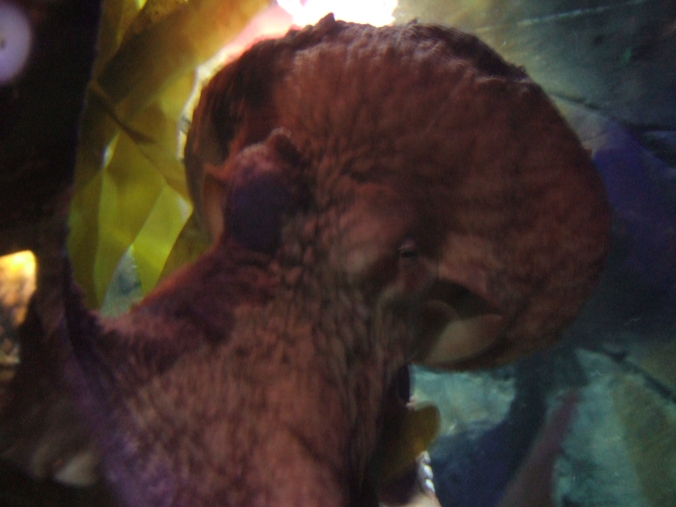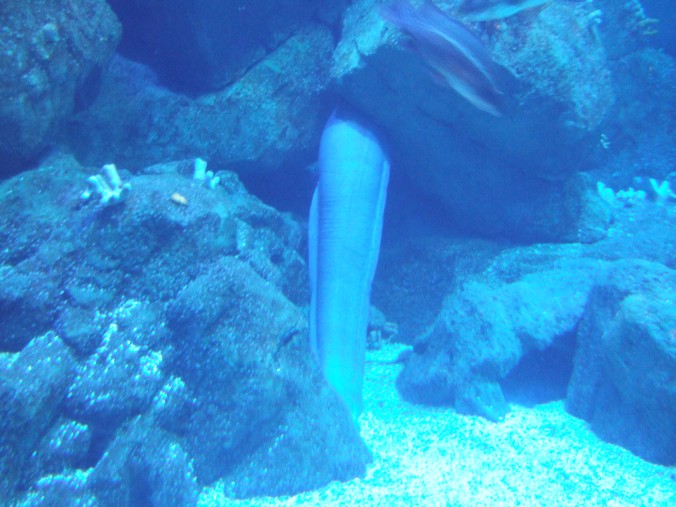One of the most impressive animals at the Plymouth Aquarium is the Giant Pacific Octopus, largest of all the octopuses in the world. Measuring 4 or more metres across the arms on average, and weighing around 10-20kg, these octopuses can be identified by their bulky frame alone. The record for a Giant Pacific is substantially bigger, the current identified record being 9.8m in arm span and 136kg altogether, an absolutely enormous specimen. No octopus has tentacles, a common misconception, since their eight prehensile limbs are actually arms, whereas a tentacle has no muscle control, such as those found on a jellyfish. By pulling in water through their head and jets, these octopus can reach speeds of 20 miles per hour over a short distance when they push the water out of their bodies at high pressure. Since an octopus has no bone in their body other than the beak, they can squeeze through any hole their beak can fit through, allowing them to fit into tiny gaps, like the octopus above. Through the contraction of tiny pigments in the skin, the octopus can change the colour and texture of its skin, blending in with its surroundings to hide from prey and predator. It is a surprisingly effective method of concealment, and it can often be hard to spot and octopus, even in its tank. The brain of the octopus is highly developed, and is tubular in shape. Strangely, the octopus will defecate inside its own head, or mantle, cavity and when there is to much waste inside it can reach into its own head through its jets and remove the unwanted substances.
The octopuses’ large size does not protect it from predators, and while smaller fish and invertebrates clear the area when it draws near, larger mammals like toothed whales and seals use their fast speeds and keen eyesight to capture these octopuses. A study in Alaska showed that not often seen Pacific Sleeper Sharks are also great predators of these molluscs, with them found almost exclusively in the stomachs of specimens brought in for study. Of course, the octopus also does its fair share of hunting, enjoying mainly a diet of shelled invertebrates, like crabs and lobsters, which are easy to catch for such a fast creature, and can be broken into using the tough beak and shell dissolving toxins. Even sharks have been known to fall prey to these animals, with pieces of them often found around octopus hides, and in one aquarium in America, a tank full of sharks disappearing. The proprietors were baffled at first, wondering who was taking their sharks, until they saw the Giant Pacific Octopus they had in the same tank, capture and suffocate one of the sharks. Needless to say, the octopus was removed to a different tank. National Geographic covered this event in a short video.
Of course, being in a different tank doesn’t always stop an octopus from eating the other denizens of the aquarium. When an octopus is bored of using its mighty brain to open jars and slip through mazes for frozen shrimps, those octopus with a grudge against society and nothing to lose apply their vast intellect to burglary. At Plymouth Aquarium, fish kept on going missing from their tanks. Again, everyone was baffled. Who was stealing these fish? How did they get in undetected? How did they lock the doors behind them when they were done? An overnight camera solved the issue. This octopus had been opening the latch of its tank, slipping out into the aquarium by night, invading other tanks and eating the fish living there. If that isn’t proof of an octopuses brainpower, then no amount of jars and mazes will ever prove anything. Truly they are the criminal masterminds of the ocean.
Octopuses are fascinating, and the Giant Pacific Octopus is the big brother of them all. I hope that one day I’ll be able to see the figures of one of these imposing animals in the murky water horizon.


